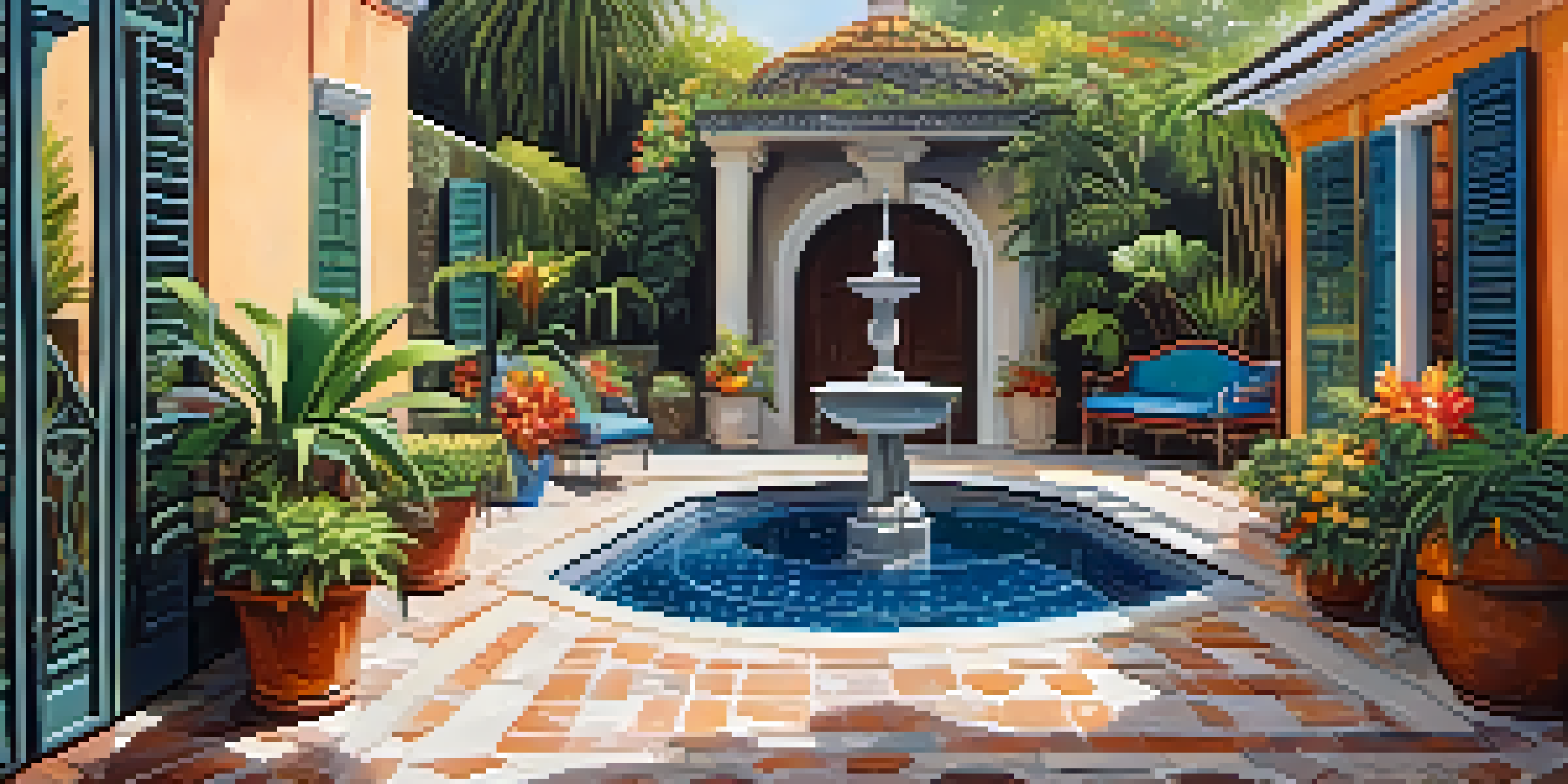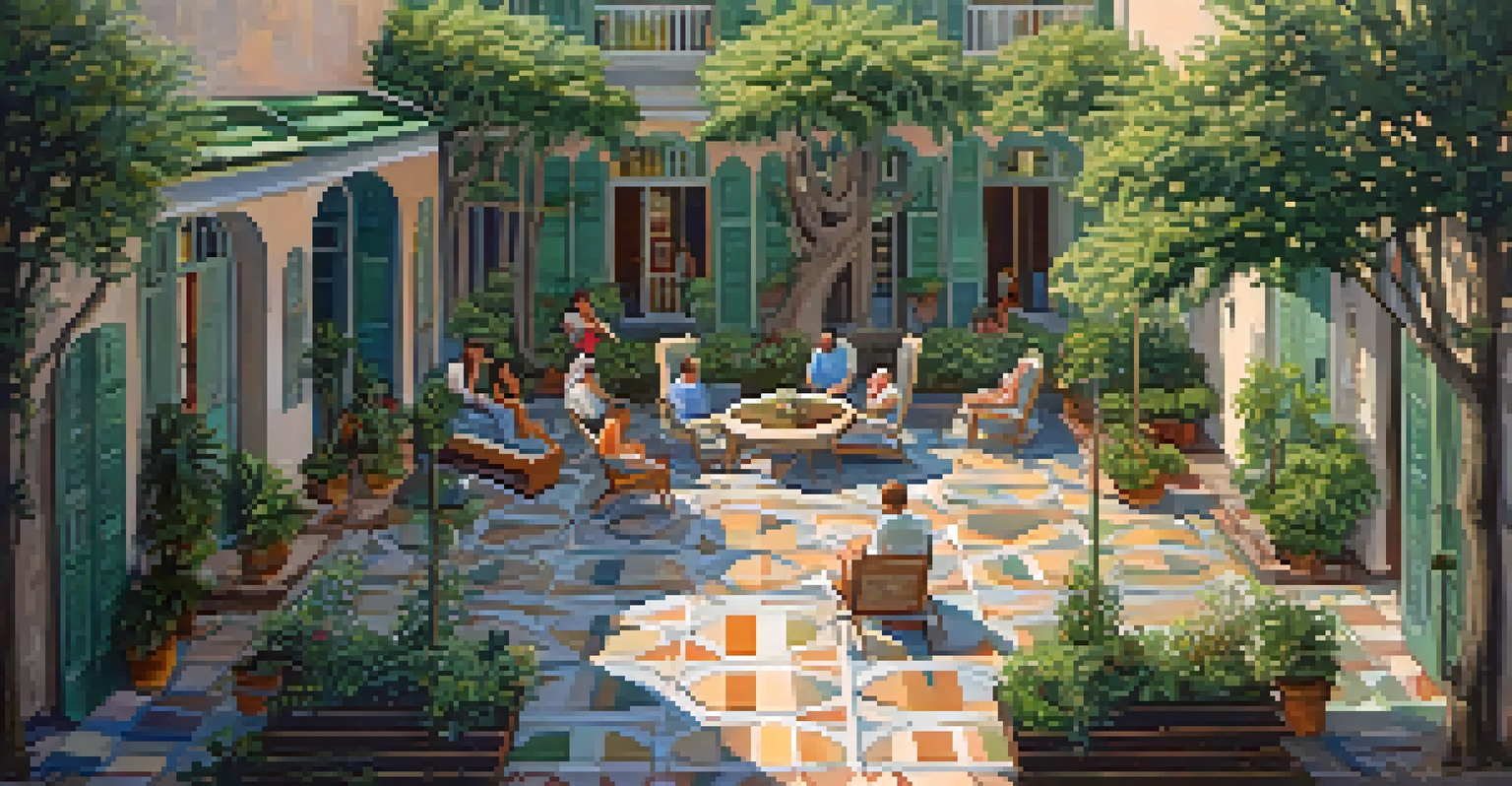The Role of Courtyards in New Orleans' Architectural Design

The Historical Significance of Courtyards in New Orleans
Courtyards have been a fundamental aspect of New Orleans architecture since colonial times. Originally designed for practical purposes, they provided a cool refuge from the heat and a space for families to gather. The influence of Spanish and French colonial styles is evident in the way these courtyards are integrated into homes, creating private outdoor spaces that invite both relaxation and social interaction.
Architecture is the learned game, correct and magnificent, of forms assembled in the light.
As the city evolved, so did the role of courtyards. They became not only functional spaces but also aesthetic focal points, reflecting the cultural richness of the area. Many historic homes feature lush gardens and intricate ironwork that draw residents and visitors alike into these serene retreats, making them a vital part of New Orleans' charm.
Today, these courtyards stand as a testament to the city's architectural legacy. They offer a glimpse into the past while serving modern needs, blending historical context with contemporary living. This duality has helped maintain New Orleans’ unique character amid urban development.
Design Elements of Courtyards in Local Architecture
Courtyards in New Orleans are characterized by their distinctive design elements, such as wrought iron gates, tiled patios, and vibrant plant life. These features not only enhance the visual appeal but also create an inviting atmosphere. The use of local materials like cypress and brick further ties the courtyards to the region's heritage.

Moreover, the layout of these spaces often encourages airflow and natural light, making them enjoyable throughout the day. Many courtyards are designed with a central focal point, such as a fountain or a statue, around which seating is arranged. This organization promotes a sense of community and encourages outdoor living, which is essential in the warm southern climate.
Courtyards Reflect Cultural Heritage
The design of courtyards in New Orleans showcases a rich blend of cultural influences, fostering community and celebrating the city's diverse history.
Incorporating elements like shade trees, climbing vines, and colorful flowers can transform a simple courtyard into a lush oasis. These design choices not only beautify the space but also provide a habitat for local wildlife, contributing to the area's biodiversity and environmental health.
The Role of Courtyards in Climate Adaptation
New Orleans' subtropical climate necessitates innovative architectural solutions, and courtyards play a pivotal role in this adaptation. By providing shaded areas and encouraging airflow, they help cool down the surrounding living spaces, making homes more comfortable without relying heavily on air conditioning. This natural cooling is not only eco-friendly but also aligns with the city's sustainability goals.
The best design is the one that integrates nature and the built environment seamlessly.
Additionally, courtyards can assist in rainwater management, which is crucial in a city prone to flooding. Many designs incorporate permeable surfaces and vegetation that absorb excess rainwater, reducing runoff and minimizing the risk of flooding. This thoughtful integration of nature into urban design showcases the importance of courtyards in promoting environmental resilience.
In essence, courtyards serve as a bridge between nature and architecture, ensuring that homes are not just beautiful but also functional and sustainable. They represent a harmonious blend of design and environmental consciousness, which is essential for New Orleans' future.
Cultural Influences on Courtyard Design
The design of courtyards in New Orleans reflects a rich tapestry of cultural influences, from Spanish and French colonial styles to African and Caribbean elements. Each culture has left its mark, creating unique spaces that embody the city’s diverse heritage. For instance, the use of vibrant colors and intricate tile work can be traced back to Spanish influences, while lush tropical plants often echo Caribbean aesthetics.
These cultural nuances not only enrich the design but also foster a sense of community among residents. Courtyards often serve as gathering spots for families and friends, promoting social interaction and cultural exchange. This communal aspect is a testament to the importance of shared spaces in urban environments.
Courtyards Enhance Urban Living
These spaces provide essential outdoor retreats that promote relaxation, recreation, and social interaction, making them vital extensions of modern homes.
As New Orleans continues to evolve, the blending of these cultural influences in courtyard design remains a vital aspect of its identity. The courtyards stand as living canvases, showcasing the city's vibrant history and the ongoing dialogue among its diverse communities.
Courtyards as Spaces for Relaxation and Recreation
In the hustle and bustle of city life, courtyards offer a serene escape where residents can unwind and enjoy leisure activities. These private outdoor spaces can be transformed into personal sanctuaries equipped with comfortable seating, hammocks, and even outdoor kitchens. They serve as ideal spots for family gatherings, barbecues, or simply enjoying a quiet evening with a good book.
Moreover, courtyards often host various recreational activities, from gardening to yoga sessions. The presence of greenery and natural elements enhances the overall experience, making these spaces not only visually appealing but also restorative. This connection to nature is essential for mental well-being, providing a much-needed respite from urban stress.
As more people seek to incorporate outdoor living into their daily routines, courtyards have become vital extensions of the home. They encourage a lifestyle that embraces nature, relaxation, and community, highlighting the importance of these spaces in modern living.
The Future of Courtyards in Urban Development
As New Orleans faces the challenges of urbanization, the future of courtyards looks promising. Architects and city planners are increasingly recognizing their value in creating livable, sustainable communities. Integrating courtyards into new developments not only preserves the city's architectural heritage but also fosters a sense of place and belonging among residents.
Innovative designs are emerging that prioritize green spaces and community interaction. By reimagining courtyards as multifunctional areas that cater to various activities, developers can enhance urban living while promoting environmental sustainability. This shift reflects a broader trend towards creating cities that prioritize quality of life and ecological balance.
Sustainable Design for the Future
As urbanization continues, courtyards are increasingly recognized for their role in creating sustainable communities that balance tradition with modern needs.
In this evolving landscape, courtyards are poised to play a crucial role in shaping the future of urban design in New Orleans. They represent a harmonious blend of tradition and modernity, ensuring that the spirit of the city continues to thrive.
Conclusion: Courtyards as Integral to New Orleans' Identity
In conclusion, courtyards are much more than architectural features in New Orleans; they are integral to the city's identity. These spaces encapsulate the cultural richness, historical significance, and innovative spirit that define New Orleans. They offer residents a unique blend of privacy and community, creating environments that enhance both living and social experiences.
As we look to the future, the importance of courtyards in urban architecture cannot be overstated. They represent a commitment to sustainability, community, and cultural preservation, all of which are essential for the ongoing vitality of the city. By embracing the role of courtyards, we can ensure that New Orleans remains a vibrant and welcoming place for generations to come.

Ultimately, courtyards are a celebration of life in New Orleans, bridging the past and future while inviting residents to engage with their surroundings. They remind us that in the heart of the city, there is always a little space for nature, community, and relaxation.